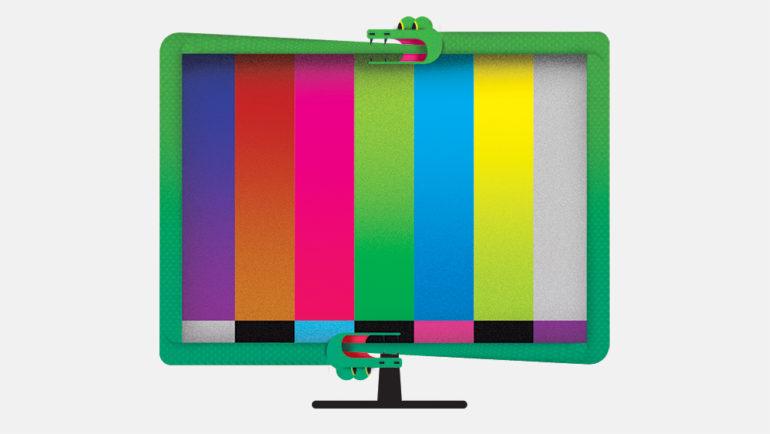Cord-Cutting Sped Up in 2018: Biggest Pay-TV Ops Shed 3.2 Million Subscribers Last Year
By Todd Spangler
LOS ANGELES (Variety.com) – Cord-cutting inflicted a heavier toll on big cable and satellite TV providers last year — and analysts expect the pain to continue into 2019.
The five biggest U.S. pay-television providers saw their traditional subscriber rolls shrink 4.2% in 2018, as they collectively lost around 3.2 million customers for the year. That’s an acceleration from estimated sector-wide declines of 3.7% in 2017 and 2% in 2016 .
Comcast, /, Charter, Dish and Verizon all sustained year-over-year net pay-TV losses, as more consumers dropped pricey bundles in favor of internet streaming video services like Netflix and free, over-the-air broadcast TV. But the agony fell disproportionately on DirecTV and Dish, which dropped 1.24 million and 1.13 million satellite subs, respectively, over 2018. (See table below.)
Many traditional pay-TV subs have downgraded to “skinny” internet bundles, including DirecTV Now and Dish’s Sling TV, which typically are cheaper than cable and satellite packages.
But so-called “virtual multichannel programming video distributors,” or vMPVDs, haven’t offset the cord-cutting exodus. A lift in vMVPD subscribers in the first half of 2018 produced a slight increase overall in pay-TV subs. But that “inflected in Q3 2018 and materially worsened in Q4 2018,” BTIG Research analyst Rich Greenfield wrote in a blog post Wednesday.
“The clear implication is that year-over-year subscriber trends for programmers that improved throughout 2018 are set to worsen again in 2019,” Greenfield wrote. The analyst is widely known as bearish on the pay-TV sector, frequently using the hashtag #goodluckbundle in his commentary (as he did in Wednesday’s post).
While virtual pay-TV services have a much lower subscriber-acquisition cost, they also have higher churn — because it’s far easier to cancel the OTT service versus cutting cable or satellite TV.
AT&T saw the effect of this in dramatic fashion in Q4. DirecTV Now lost 267,000 net subscribers in the quarter , after the company ended virtually all promotional pricing offers, some as low as $10 per month, by the end of 2018. AT&T had about 500,000 DirecTV Now subs on promo prices, and “they are all gone or they stepped up” to a full-price plan, CFO John Stephens told analysts on the telco’s earnings call.
One note: Dish suffered record satellite TV net loss of 381,000 customers in the fourth quarter of 2018, which was driven by the ongoing blackouts of HBO and Univision programming . That said, Dish’s satellite losses didn’t result in commensurate gains among its traditional rivals.
Meanwhile, it’s worth pointing out that the numbers crunched here don’t account for subscriber gains at new OTT-only entrants: YouTube TV, Hulu With Live TV, Sony PlayStation Vue, FuboTV and Philo. At this point, the group may be moving the needle only slightly for total pay-TV sub numbers. Hulu, for example, claims it first hit 1 million customers for its live-TV service last fall and FuboTV said it had nearly 250,000 paid subscribers at the end of September.
U.S. Pay-TV Subscriber Trends (in thousands)
| Service | Subs at end of 2018 | Q4 2018 loss/gain | Net loss/gain for 2018 | Year-over-year % change |
| Xfinity | 20,959 | (19) | (344) | -1.6% |
| DirecTV satellite | 19,222 | (403) | (1,236) | -6.0% |
| Charter | 16,104 | (36) | (296) | -1.8% |
| Dish satellite | 9,905 | (381) | (1,125) | -10.2% |
| Fios | 4,451 | (46) | (168) | -3.6% |
| AT&T U-verse | 3,681 | 12 | (50) | -1.3 |
| Sling TV | 2,417 | 47 | 205 | 9.3% |
| DirecTV Now | 1,591 | (267) | 436 | 37.7% |
| TOTAL | 78,330 | (1,093) | (2,578) | -3.2% |
| TOTAL excluding OTT services | 74,322 | (873) | (3,219) | -4.2% |
Source: Company reports
Note: Excludes cable operators including Cox, Altice USA and Mediacom

